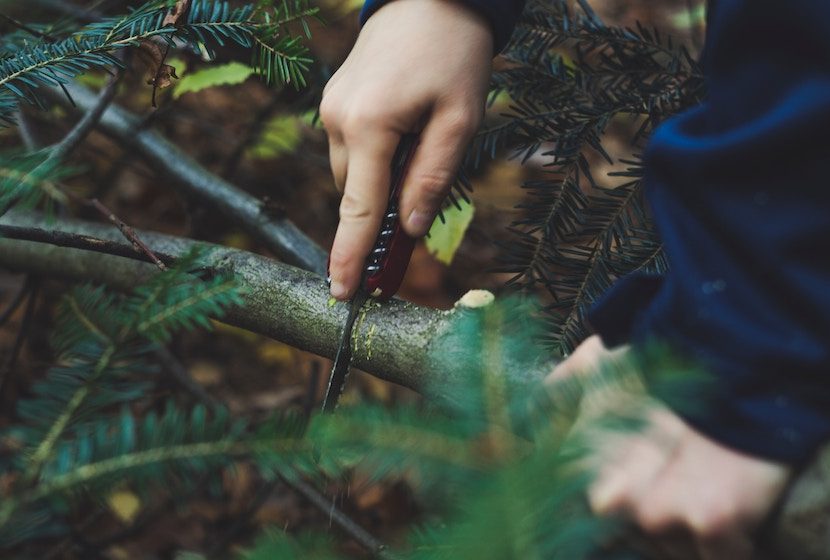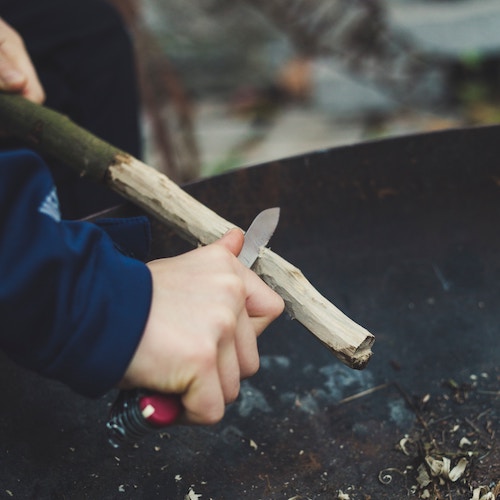When it comes to knife safety, there is only one simple rule: Don’t cut yourself. Especially when in the field. The farther you are from medical aid, the more careful you must be. When in a survival situation, slow, deliberate movements are necessary to ensure you don’t inadvertently lop off a finger or slash open your leg. The possibility of infection is much greater when you are the most vulnerable. Not because your present location or situation dictates it, but because you are so, in fact, vulnerable; and Murphy will inevitably show his face just when you can least survive his presence. I have outlined some simple knife safety tips to use when in the field or whenever handling a knife.
1. Sharpen your knife. It may seem counterintuitive, but a sharp knife is, in fact, safer than a dull knife. You need less strength to cut through your work piece, and are less likely to over cut or over strike at the completion of your cutting stroke. If you are a gun guy, think of over striking like over travel with your trigger. That over strike can lead to a very dangerous situation for anyone that is with you; which leads me to my next point…
2. Always ensure that no one is with arms reach of you when you are using your knife. Inevitably, when you least expect it, your friend or child will enter your work space and want to watch you work. When whittling through your work piece, you will encounter knots and fibrous sections that will require extra muscle to get through, and your over strike may harm another person.
3. Be mindful of the Triangle of Death. That is essentially the area between the three points of your torso (or crotch) and each of your knees. There are so many things that can go wrong when wielding a very sharp knife and doing so in an area so flush with large blood vessels, including not a small amount of arteries, can lead to some serious trouble and aforementioned infection.
4. Always cut away from yourself. Seems simple right? I have personally seen men that are considered subject matter experts express this simple rule as they are actually cutting toward themselves. I always found that to be quite ironic, and have never been surprised when I see these folks end up cutting themselves only to say “See? That’s why you never cut toward yourself.” There are so many ways to execute a cut into wood or most any other medium that cutting toward yourself is almost never necessary.
5. When performing finer work, try to get a thumb on the spine (back) of the blade. This will give you greater leverage with your wrist and allow you to focus your energy on that part of your arm instead of trying to push through with your entire arm, which may lead to dangerous over strikes. Some knifes have a finger choil for placement of your index finger which allows for even finer work with the base of the cutting edge of the blade. I advise caution with this technique and only recommend its use to experienced knife handlers.
6. When you are able, rotate your work piece, not your knife. You want to maintain a constant grip on your knife to ensure the highest likelihood of consistency in your cutting and to allow your muscle memory to take hold to keep things as safe as possible.
7. When working with deep cuts and things like knots or very fibrous wood, use either a chest lever or, my preferred method, the knee lever. It allows you to keep you knife nearly static in a solid position and to move your work piece instead of your knife. This helps to prevent to most common result of harder cutting, which is over striking. It also uses less arm strength since the motion relies mostly on your back muscles for the pulling.
8. Sheath your knife when you are not using it. You would not believe the stories I have heard and read about folks that were injured by their knives or axes when they are not even holding them.
9. Use try sticks. If you don’t know what these are, they are very simply a stick that you try out your notching and cutting with. It helps to fine tune your ability and to give you greater confidence when using your knife.
As a last note, I would like to express to you what I believe is the absolute most dangerous thing you can do with knife. That is to use one while fatigued. When you are tired you get into a rush and you get impatient. You try to work around safe knife practice or simply forget it altogether. Throughout history, there have been stories about experienced men injuring themselves, and not a few dying from it, because they were tired and/or in a hurry.
Slow down, be safe, and Don’t Die Dumb !





I created a set of rules to mimic the 4 universal firearms safety rules. Think 4 is going to be easier for my young kids to remember. Thought I’d share.
1. Treat every edge as if it is sharp
2. Do not touch or move the knife toward anything you’re not willing to cut
3. Keep the blade closed or sheathed until ready to cut
4. Always know who and what is in your blood circle